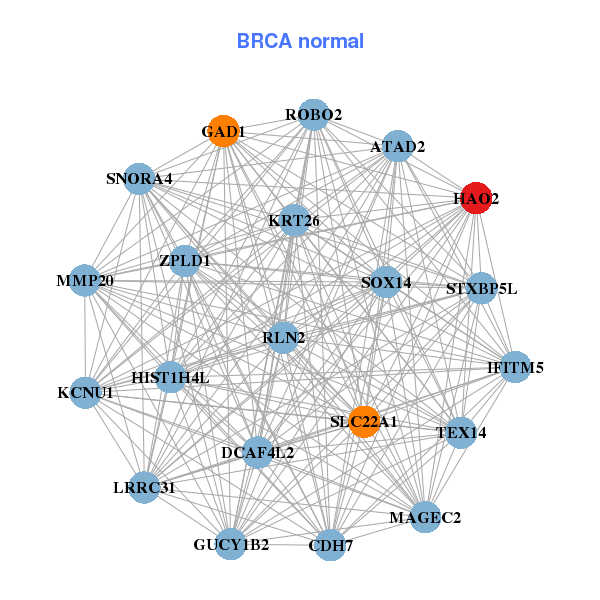|
||||||||||||||||||||||||||||||||||||||||||||||||||||||||||||||||||||||||||||||||||||||||||||||||||||||||||||||||||||||||||||||||||||||||||||||||||||||||||||||||||||||||||||||||||||||||||||||||||||||||||||||||||||||||||||||||||||||||||||||||||||||||||||||||||||||||||||||||||||||||||||||||||||||||||||||||||||||||||
| |
| Phenotypic Information (metabolism pathway, cancer, disease, phenome) |
| |
| |
| Gene-Gene Network Information: Co-Expression Network, Interacting Genes & KEGG |
| |
|
| Gene Summary for HAO2 |
| Basic gene info. | Gene symbol | HAO2 |
| Gene name | hydroxyacid oxidase 2 (long chain) | |
| Synonyms | GIG16|HAOX2 | |
| Cytomap | UCSC genome browser: 1p13.3-p13.1 | |
| Genomic location | chr1 :119911401-119936751 | |
| Type of gene | protein-coding | |
| RefGenes | NM_001005783.2, NM_016527.3, | |
| Ensembl id | ENSG00000116882 | |
| Description | (S)-2-hydroxy-acid oxidase, peroxisomalcell growth-inhibiting gene 16 proteinglycolate oxidasehydroxyacid oxidase 2long chain alpha-hydroxy acid oxidaselong-chain L-2-hydroxy acid oxidase | |
| Modification date | 20141211 | |
| dbXrefs | MIM : 605176 | |
| HGNC : HGNC | ||
| Ensembl : ENSG00000116882 | ||
| HPRD : 05532 | ||
| Vega : OTTHUMG00000012410 | ||
| Protein | UniProt: go to UniProt's Cross Reference DB Table | |
| Expression | CleanEX: HS_HAO2 | |
| BioGPS: 51179 | ||
| Gene Expression Atlas: ENSG00000116882 | ||
| The Human Protein Atlas: ENSG00000116882 | ||
| Pathway | NCI Pathway Interaction Database: HAO2 | |
| KEGG: HAO2 | ||
| REACTOME: HAO2 | ||
| ConsensusPathDB | ||
| Pathway Commons: HAO2 | ||
| Metabolism | MetaCyc: HAO2 | |
| HUMANCyc: HAO2 | ||
| Regulation | Ensembl's Regulation: ENSG00000116882 | |
| miRBase: chr1 :119,911,401-119,936,751 | ||
| TargetScan: NM_001005783 | ||
| cisRED: ENSG00000116882 | ||
| Context | iHOP: HAO2 | |
| cancer metabolism search in PubMed: HAO2 | ||
| UCL Cancer Institute: HAO2 | ||
| Assigned class in ccmGDB | C | |
| Top |
| Phenotypic Information for HAO2(metabolism pathway, cancer, disease, phenome) |
| Cancer | CGAP: HAO2 |
| Familial Cancer Database: HAO2 | |
| * This gene is included in those cancer gene databases. |
|
|
|
|
|
|
| ||||||||||||||||||||||||||||||||||||||||||||||||||||||||||||||||||||||||||||||||||||||||||||||||||||||||||||||||||||||||||||||||||||||||||||||||||||||||||||||||||||||||||||||||||||||||||||||||||||||||||||||||||||||||||||||||||||||||||||||||||||||||||||||||||||||||||||||||||||||||||||||||||||||||||||||||||||
Oncogene 1 | Significant driver gene in | |||||||||||||||||||||||||||||||||||||||||||||||||||||||||||||||||||||||||||||||||||||||||||||||||||||||||||||||||||||||||||||||||||||||||||||||||||||||||||||||||||||||||||||||||||||||||||||||||||||||||||||||||||||||||||||||||||||||||||||||||||||||||||||||||||||||||||||||||||||||||||||||||||||||||||||||||||||||||
| cf) number; DB name 1 Oncogene; http://nar.oxfordjournals.org/content/35/suppl_1/D721.long, 2 Tumor Suppressor gene; https://bioinfo.uth.edu/TSGene/, 3 Cancer Gene Census; http://www.nature.com/nrc/journal/v4/n3/abs/nrc1299.html, 4 CancerGenes; http://nar.oxfordjournals.org/content/35/suppl_1/D721.long, 5 Network of Cancer Gene; http://ncg.kcl.ac.uk/index.php, 1Therapeutic Vulnerabilities in Cancer; http://cbio.mskcc.org/cancergenomics/statius/ |
| KEGG_GLYOXYLATE_AND_DICARBOXYLATE_METABOLISM | |
| OMIM | |
| Orphanet | |
| Disease | KEGG Disease: HAO2 |
| MedGen: HAO2 (Human Medical Genetics with Condition) | |
| ClinVar: HAO2 | |
| Phenotype | MGI: HAO2 (International Mouse Phenotyping Consortium) |
| PhenomicDB: HAO2 | |
| Mutations for HAO2 |
| * Under tables are showing count per each tissue to give us broad intuition about tissue specific mutation patterns.You can go to the detailed page for each mutation database's web site. |
| - Statistics for Tissue and Mutation type | Top |
 |
| - For Inter-chromosomal Variations |
| * Inter-chromosomal variantions includes 'interchromosomal amplicon to amplicon', 'interchromosomal amplicon to non-amplified dna', 'interchromosomal insertion', 'Interchromosomal unknown type'. |
 |
| - For Intra-chromosomal Variations |
| * Intra-chromosomal variantions includes 'intrachromosomal amplicon to amplicon', 'intrachromosomal amplicon to non-amplified dna', 'intrachromosomal deletion', 'intrachromosomal fold-back inversion', 'intrachromosomal inversion', 'intrachromosomal tandem duplication', 'Intrachromosomal unknown type', 'intrachromosomal with inverted orientation', 'intrachromosomal with non-inverted orientation'. |
 |
| Sample | Symbol_a | Chr_a | Start_a | End_a | Symbol_b | Chr_b | Start_b | End_b |
| pancreas | HAO2 | chr1 | 119917280 | 119917300 | chr4 | 62283747 | 62283767 | |
| pancreas | HAO2 | chr1 | 119917290 | 119917290 | chr4 | 62283758 | 62283758 | |
| pancreas | HAO2 | chr1 | 119920408 | 119920428 | HAO2 | chr1 | 119922878 | 119922898 |
| pancreas | HAO2 | chr1 | 119930995 | 119931015 | HAO2 | chr1 | 119930910 | 119930930 |
| cf) Tissue number; Tissue name (1;Breast, 2;Central_nervous_system, 3;Haematopoietic_and_lymphoid_tissue, 4;Large_intestine, 5;Liver, 6;Lung, 7;Ovary, 8;Pancreas, 9;Prostate, 10;Skin, 11;Soft_tissue, 12;Upper_aerodigestive_tract) |
| * From mRNA Sanger sequences, Chitars2.0 arranged chimeric transcripts. This table shows HAO2 related fusion information. |
| ID | Head Gene | Tail Gene | Accession | Gene_a | qStart_a | qEnd_a | Chromosome_a | tStart_a | tEnd_a | Gene_a | qStart_a | qEnd_a | Chromosome_a | tStart_a | tEnd_a |
| AI110601 | RECQL | 1 | 180 | 12 | 21654120 | 21654546 | HAO2 | 175 | 538 | 1 | 119928261 | 119928624 | |
| AF062709 | RECQL | 1 | 180 | 12 | 21654120 | 21654546 | HAO2 | 175 | 538 | 1 | 119928261 | 119928624 | |
| BI759383 | HAO2 | 1 | 160 | 1 | 119935247 | 119941320 | HAO2 | 160 | 579 | 1 | 119934732 | 119936597 | |
| Top |
| Mutation type/ Tissue ID | brca | cns | cerv | endome | haematopo | kidn | Lintest | liver | lung | ns | ovary | pancre | prost | skin | stoma | thyro | urina | |||
| Total # sample | 1 | 2 | ||||||||||||||||||
| GAIN (# sample) | 1 | 2 | ||||||||||||||||||
| LOSS (# sample) |
| cf) Tissue ID; Tissue type (1; Breast, 2; Central_nervous_system, 3; Cervix, 4; Endometrium, 5; Haematopoietic_and_lymphoid_tissue, 6; Kidney, 7; Large_intestine, 8; Liver, 9; Lung, 10; NS, 11; Ovary, 12; Pancreas, 13; Prostate, 14; Skin, 15; Stomach, 16; Thyroid, 17; Urinary_tract) |
| Top |
|
 |
| Top |
| Stat. for Non-Synonymous SNVs (# total SNVs=51) | (# total SNVs=11) |
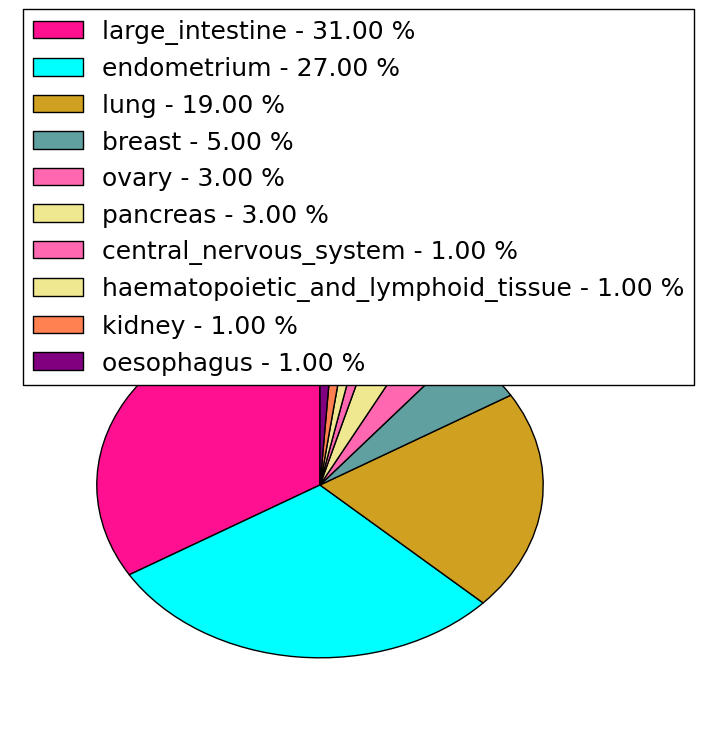 |  |
(# total SNVs=0) | (# total SNVs=0) |
| Top |
| * When you move the cursor on each content, you can see more deailed mutation information on the Tooltip. Those are primary_site,primary_histology,mutation(aa),pubmedID. |
| GRCh37 position | Mutation(aa) | Unique sampleID count |
| chr1:119925542-119925542 | p.R46C | 3 |
| chr1:119936413-119936413 | p.R336W | 3 |
| chr1:119927624-119927624 | p.R170Q | 3 |
| chr1:119936414-119936414 | p.R336Q | 3 |
| chr1:119923749-119923749 | p.R14Q | 2 |
| chr1:119929411-119929411 | p.V243A | 2 |
| chr1:119927596-119927596 | p.V161L | 2 |
| chr1:119925543-119925543 | p.R46H | 2 |
| chr1:119929330-119929330 | p.R216Q | 2 |
| chr1:119925552-119925552 | p.P49L | 2 |
| Top |
|
 |
| Point Mutation/ Tissue ID | 1 | 2 | 3 | 4 | 5 | 6 | 7 | 8 | 9 | 10 | 11 | 12 | 13 | 14 | 15 | 16 | 17 | 18 | 19 | 20 |
| # sample | 2 | 1 | 6 | 1 | 1 | 2 | 7 | 2 | 14 | 3 | 11 | |||||||||
| # mutation | 2 | 1 | 5 | 1 | 1 | 2 | 12 | 1 | 17 | 3 | 12 | |||||||||
| nonsynonymous SNV | 2 | 1 | 5 | 1 | 1 | 9 | 1 | 9 | 3 | 11 | ||||||||||
| synonymous SNV | 1 | 2 | 3 | 8 | 1 |
| cf) Tissue ID; Tissue type (1; BLCA[Bladder Urothelial Carcinoma], 2; BRCA[Breast invasive carcinoma], 3; CESC[Cervical squamous cell carcinoma and endocervical adenocarcinoma], 4; COAD[Colon adenocarcinoma], 5; GBM[Glioblastoma multiforme], 6; Glioma Low Grade, 7; HNSC[Head and Neck squamous cell carcinoma], 8; KICH[Kidney Chromophobe], 9; KIRC[Kidney renal clear cell carcinoma], 10; KIRP[Kidney renal papillary cell carcinoma], 11; LAML[Acute Myeloid Leukemia], 12; LUAD[Lung adenocarcinoma], 13; LUSC[Lung squamous cell carcinoma], 14; OV[Ovarian serous cystadenocarcinoma ], 15; PAAD[Pancreatic adenocarcinoma], 16; PRAD[Prostate adenocarcinoma], 17; SKCM[Skin Cutaneous Melanoma], 18:STAD[Stomach adenocarcinoma], 19:THCA[Thyroid carcinoma], 20:UCEC[Uterine Corpus Endometrial Carcinoma]) |
| Top |
| * We represented just top 10 SNVs. When you move the cursor on each content, you can see more deailed mutation information on the Tooltip. Those are primary_site, primary_histology, mutation(aa), pubmedID. |
| Genomic Position | Mutation(aa) | Unique sampleID count |
| chr1:119936413 | p.R336W,HAO2 | 4 |
| chr1:119923746 | p.A13V,HAO2 | 3 |
| chr1:119923812 | p.A98V,HAO2 | 2 |
| chr1:119923749 | p.R35L,HAO2 | 2 |
| chr1:119927408 | p.R14L,HAO2 | 2 |
| chr1:119923771 | p.F24C,HAO2 | 1 |
| chr1:119929330 | p.A96A,HAO2 | 1 |
| chr1:119925580 | p.V243A,HAO2 | 1 |
| chr1:119936422 | p.G28E,HAO2 | 1 |
| chr1:119927430 | p.Q97R,HAO2 | 1 |
| * Copy number data were extracted from TCGA using R package TCGA-Assembler. The URLs of all public data files on TCGA DCC data server were gathered on Jan-05-2015. Function ProcessCNAData in TCGA-Assembler package was used to obtain gene-level copy number value which is calculated as the average copy number of the genomic region of a gene. |
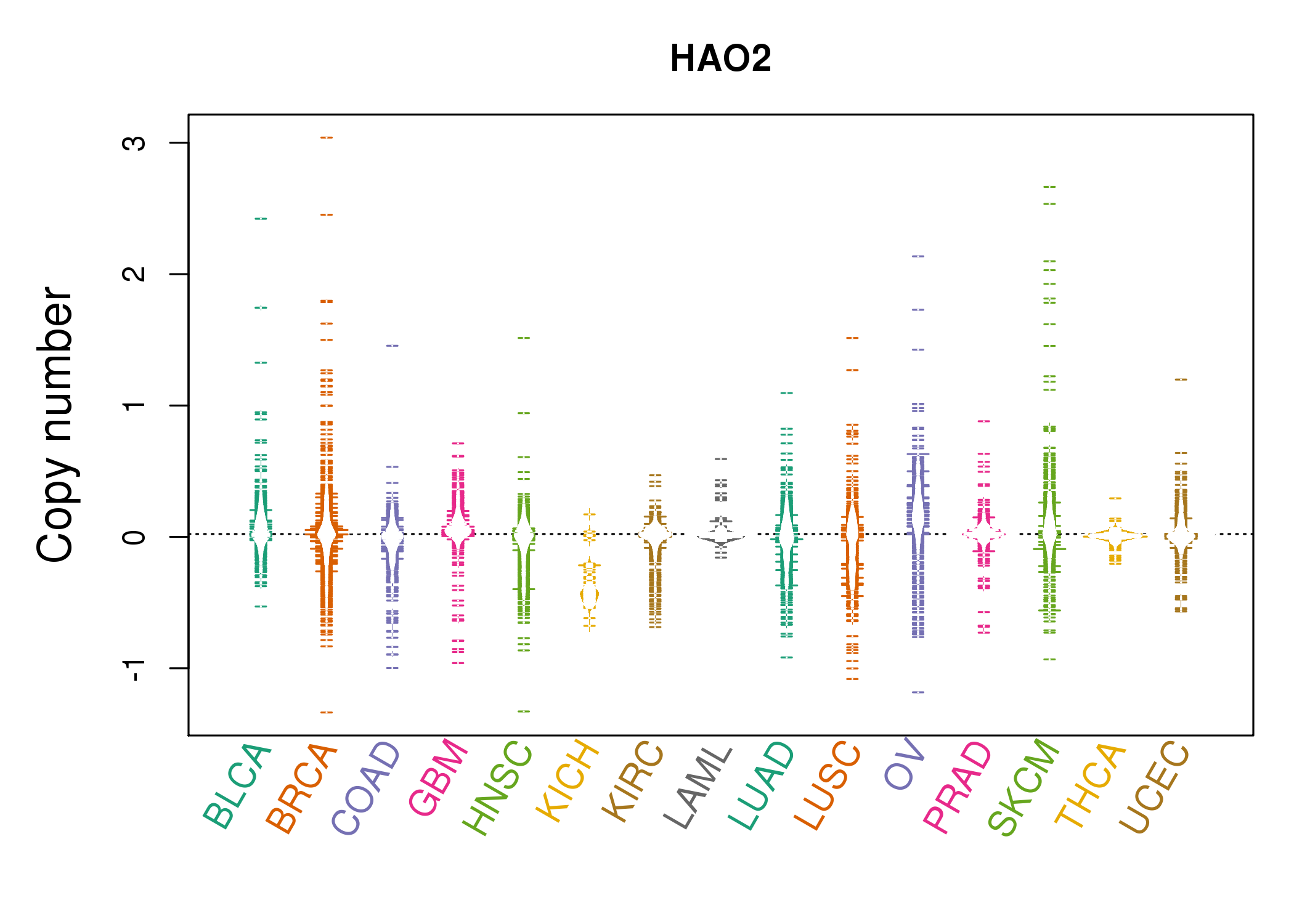 |
| cf) Tissue ID[Tissue type]: BLCA[Bladder Urothelial Carcinoma], BRCA[Breast invasive carcinoma], CESC[Cervical squamous cell carcinoma and endocervical adenocarcinoma], COAD[Colon adenocarcinoma], GBM[Glioblastoma multiforme], Glioma Low Grade, HNSC[Head and Neck squamous cell carcinoma], KICH[Kidney Chromophobe], KIRC[Kidney renal clear cell carcinoma], KIRP[Kidney renal papillary cell carcinoma], LAML[Acute Myeloid Leukemia], LUAD[Lung adenocarcinoma], LUSC[Lung squamous cell carcinoma], OV[Ovarian serous cystadenocarcinoma ], PAAD[Pancreatic adenocarcinoma], PRAD[Prostate adenocarcinoma], SKCM[Skin Cutaneous Melanoma], STAD[Stomach adenocarcinoma], THCA[Thyroid carcinoma], UCEC[Uterine Corpus Endometrial Carcinoma] |
| Top |
| Gene Expression for HAO2 |
| * CCLE gene expression data were extracted from CCLE_Expression_Entrez_2012-10-18.res: Gene-centric RMA-normalized mRNA expression data. |
 |
| * Normalized gene expression data of RNASeqV2 was extracted from TCGA using R package TCGA-Assembler. The URLs of all public data files on TCGA DCC data server were gathered at Jan-05-2015. Only eight cancer types have enough normal control samples for differential expression analysis. (t test, adjusted p<0.05 (using Benjamini-Hochberg FDR)) |
 |
| Top |
| * This plots show the correlation between CNV and gene expression. |
: Open all plots for all cancer types
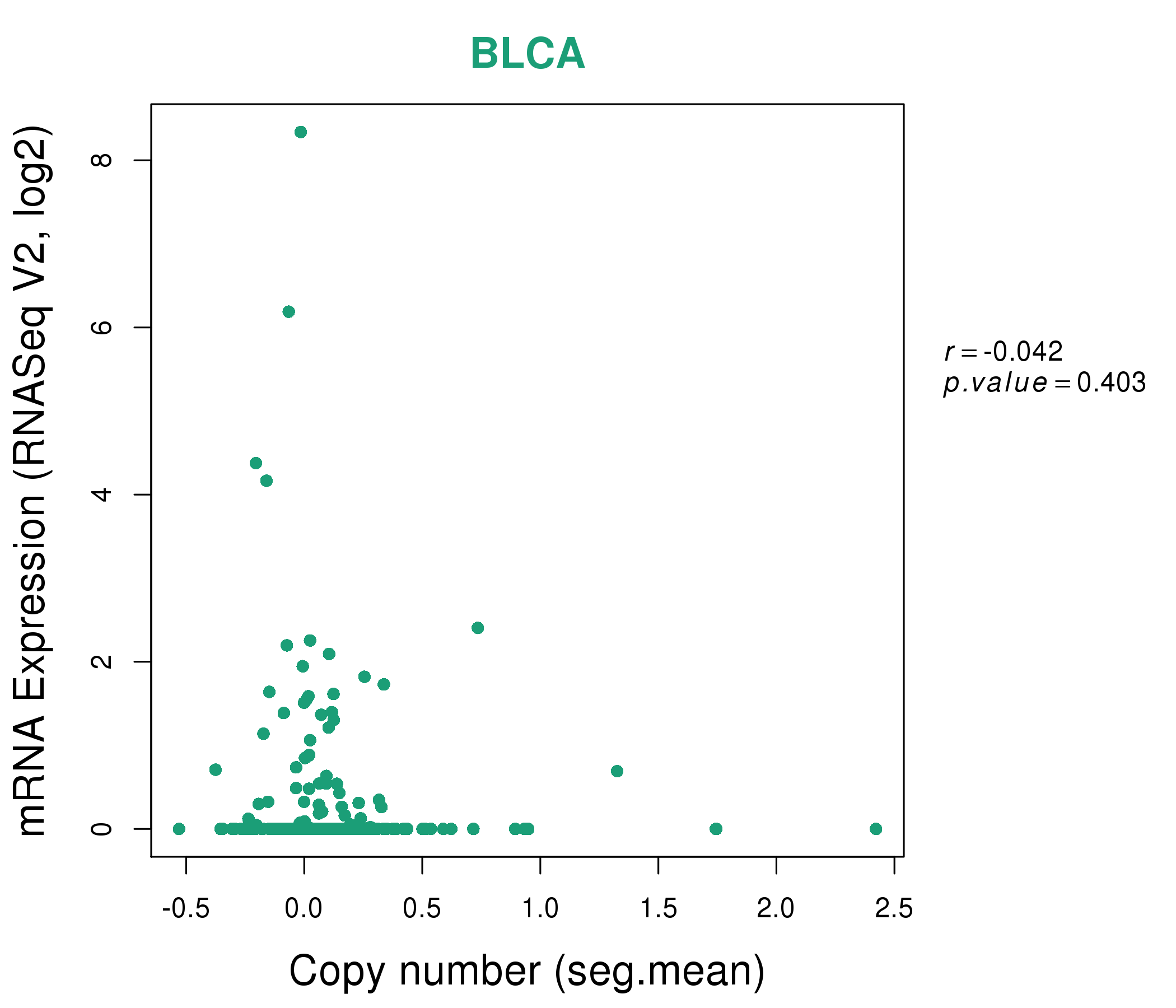 |
|
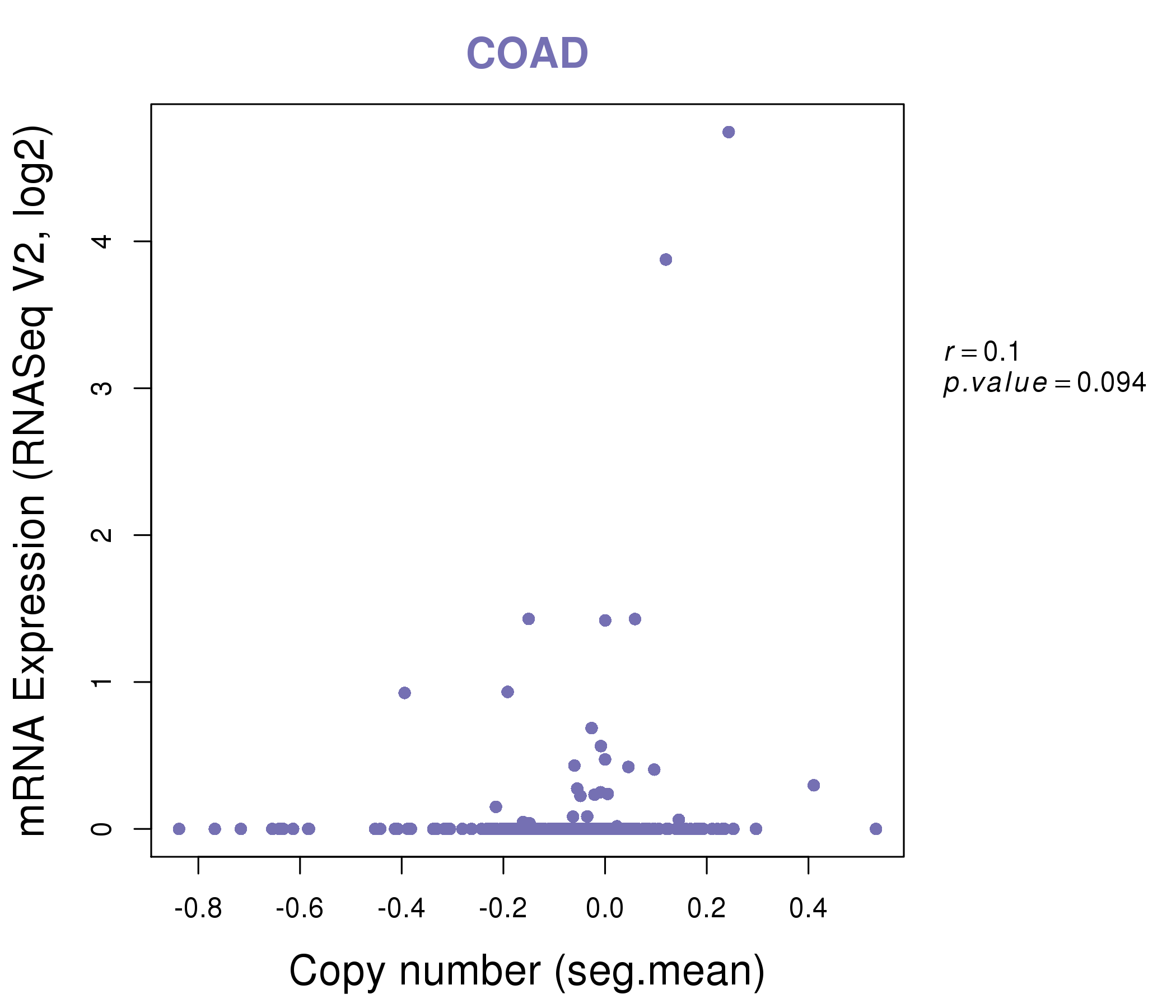 |
|
| Top |
| Gene-Gene Network Information |
| * Co-Expression network figures were drawn using R package igraph. Only the top 20 genes with the highest correlations were shown. Red circle: input gene, orange circle: cell metabolism gene, sky circle: other gene |
: Open all plots for all cancer types
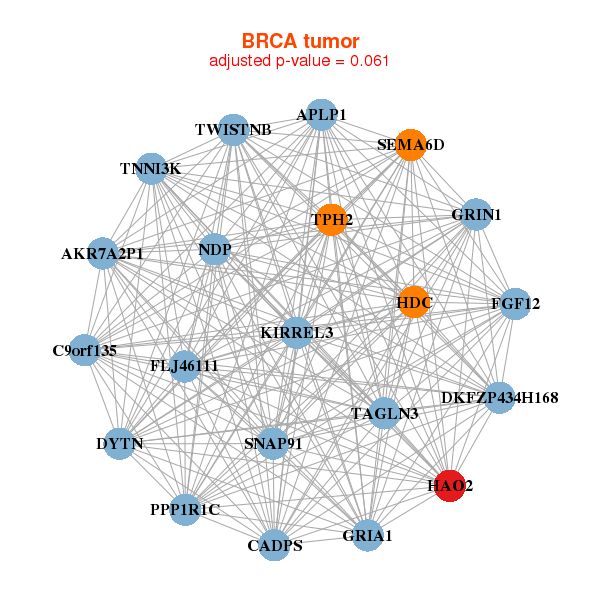 |
|
| AKR7A2P1,APLP1,C9orf135,CADPS,DKFZP434H168,DYTN,FGF12, FLJ46111,GRIA1,GRIN1,HAO2,HDC,KIRREL3,NDP, PPP1R1C,SEMA6D,SNAP91,TAGLN3,TNNI3K,TPH2,TWISTNB | ATAD2,CDH7,DCAF4L2,GAD1,GUCY1B2,HAO2,HIST1H4L, IFITM5,KCNU1,KRT26,LRRC31,MAGEC2,MMP20,RLN2, ROBO2,SLC22A1,SNORA4,SOX14,STXBP5L,TEX14,ZPLD1 |
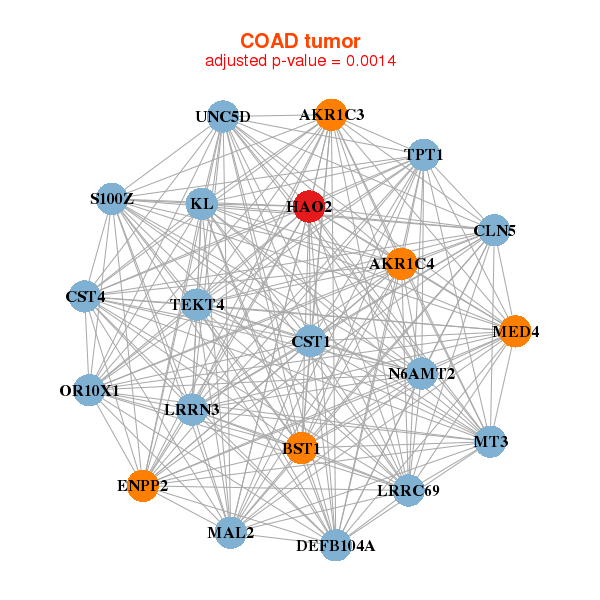 |
|
| AKR1C3,AKR1C4,BST1,CLN5,CST1,CST4,DEFB104A, ENPP2,HAO2,KL,LRRC69,LRRN3,MAL2,MED4, MT3,N6AMT2,OR10X1,S100Z,TEKT4,TPT1,UNC5D | BST1,CRYAA,DACH1,GATA4,GGT3P,GGTLC1,HAO2, HEATR4,HTR4,KCNK17,LCT,LEMD1,PAEP,PDIA2, ProSAPiP1,RGS7BP,SFTA3,SLC34A2,SNORA80E,TBX18,TMPRSS11D |
| * Co-Expression network figures were drawn using R package igraph. Only the top 20 genes with the highest correlations were shown. Red circle: input gene, orange circle: cell metabolism gene, sky circle: other gene |
: Open all plots for all cancer types
| Top |
: Open all interacting genes' information including KEGG pathway for all interacting genes from DAVID
| Top |
| Pharmacological Information for HAO2 |
| There's no related Drug. |
| Top |
| Cross referenced IDs for HAO2 |
| * We obtained these cross-references from Uniprot database. It covers 150 different DBs, 18 categories. http://www.uniprot.org/help/cross_references_section |
: Open all cross reference information
|
Copyright © 2016-Present - The Univsersity of Texas Health Science Center at Houston @ |








